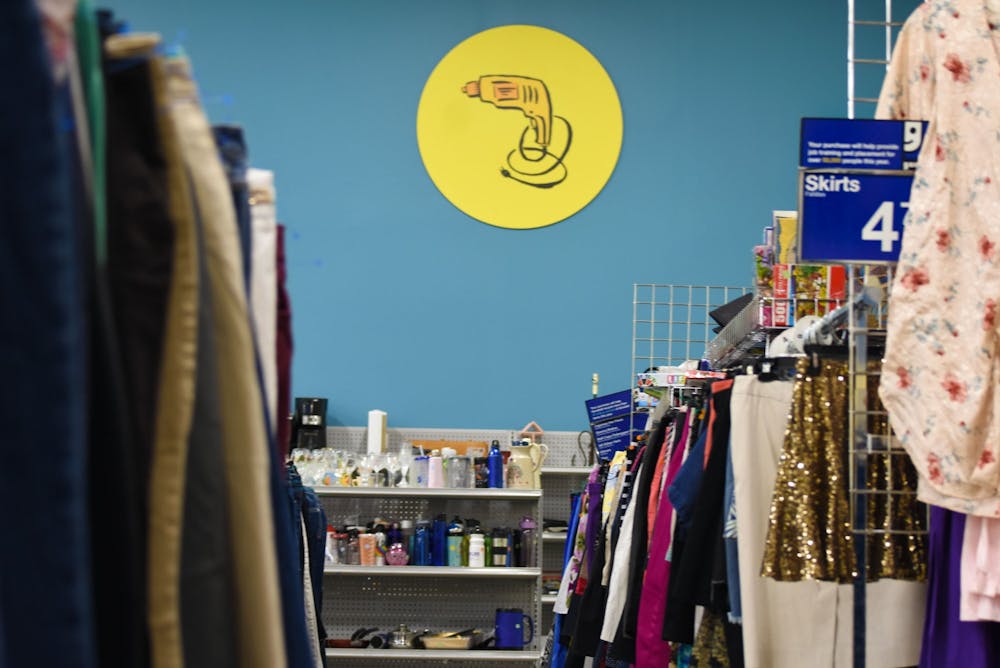Many students and Columbia residents participate in and build the local thrifting community. In Columbia alone, there are a large number of thrift and second-hand stores that have become popular places for students to shop.
Not only that, but many students have turned this pastime into financial gains through the capabilities of the internet.
Gray Thomas, a fourth-year advertising student, who runs the @sodacitythrifts' Instagram account, mainly sells clothes to USC students. He said he finds most of the items he sells through thrifting and reposts on his Instagram story from local thrift shops.
“I'll sell it for typically $10 just because I know a college kid is not going to pay much more than $10,” Thomas said.
Every once in a while, however, he finds something a little too rare to sell for cheap.
“We pulled out this NASCAR UPS, like actual racers jacket and, like — that you'd see, like, the NASCAR drivers wear while they're driving,” Thomas said.
The NASCAR jacket sold for around $100.
Thomas has multiple items for sale on the Soda City Thrifts account, which are available for the public. When an interested buyer wants to purchase a piece, all they have to do is swipe up and ask if the item is still available.
In addition to chain thrift stores in Columbia, such as multiple Goodwills or Plato's Closet, are local options, such as Five Points' Sid & Nancy and its sister store Revente. Besides these options, flea markets and estate sales provide unique ways to thrift.
Cheyann Dow, a first-year psychology student, said she loves to go thrifting for sweaters. She goes almost twice a week. Her favorite thing she has found was a $5 Dior sweater, which she managed to sell for around $60, she said.
Many aspects of thrifting trends also happen through digital outlets.
Victoria Lynch, a fourth-year advertising student, said she does most of her thrifting through Facebook marketplace and e-commerce apps. She even used Facebook Marketplace to sublease an apartment in Boston for the summer.
Thrifting can yield more than just clothes and accessories.
Lynch said she used ideas from Google Images to design her own pallet couch. The entire couch, made of reclaimed pallet wood and fabrics, was cheap to make. She said she got the pallets from a warehouse near Olympia Mills and pillows and blankets from Goodwill.
"It maybe, total, cost me like $15, but it looks really cool,” said Lynch.
Today, it sits out on her patio.
And if you’re looking for something a bit stranger than clothes or pillows, Facebook Marketplace has got you covered. According to Lynch, “people sell, like, fake-looking hands and fingers.”
"Sometimes, I'll filter for local just to see what's going on," Lynch said.
Thrifting also does more than help college students save money, as it’s a way to combat fast fashion and environmental effects of the clothing and trash industry.
Fast fashion is the trend of quickly moving clothing articles from catwalks to stores, then repeating that process the moment a new trend begins. The articles of clothing get mass produced, and once the trend goes out of style, the clothes are taken off the shelves at stores. Fast fashion contributes to 10% of global carbon emissions every year.
“It's just really good for the environment, and you don't realize how much clothes can become a waste,” Lynch said.
Dow said if she buys new clothes, she sometimes doesn't wear them that often.
"It's easier for me to use someone else's clothes that they've worn for a while and just reuse them and then donate them again, and they can get reused," Dow said.
This is why thrifting appeals to her more than buying firsthand. It offers cheaper clothes that she knows will be used again after her.
Thrifting and buying from local vendors gives people ways to show off their talents and profit off them. By shopping local and recycled, rather than buying everything new, students across campus are saving money, growing their bank accounts and helping the environment.

